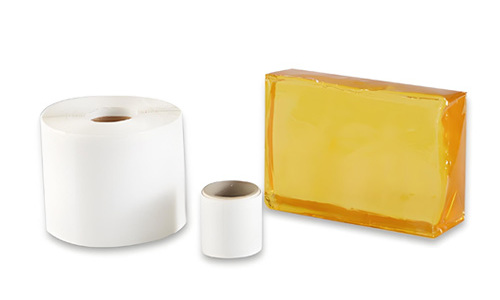Today we will analyze how SIS materials affect the performance of hot melt pressure sensitive adhesives. SIS is a block polymer of styrene and isoprene. Its technical parameters mainly include SIS structure (linear or radial), S/I ratio, molecular weight and di-block (SI) content. Affected by the mid-block polyisoprene side chain methyl group, SIS has good cohesion and adhesion properties, also has the characteristics of low modulus, good elasticity, low melt viscosity, good strength and good coating performance. Therefore, SIS is an excellent main material for preparing hot melt pressure sensitive adhesive (HMPSA), and is widely used in the production of pressure sensitive tape and label paper. HMPSA refers to a semi-dry solid that is coated on a substrate when heated to a molten state and has permanent initial tack after cooling. The properties are mainly characterized by initial tack, cohesion and 180°peel strength. In addition, HMPSA softening point, slitting performance, and melt viscosity are often properties that users care about. The influence of molecular structure on the properties of SIS hot melt pressure sensitive adhesive SIS includes linear and radial structures. Compared with linear SIS, the radial SIS structure has higher cross-link density, higher molecular weight, good heat resistance, strong stickiness, and high elastic modulus. The HMPSA prepared by linear SIS has lower melt viscosity and High initial tack, which is beneficial to coating processing.According to our experience,the radial structure SIS is usually used to make solvent-based adhesives, and the linear structure SIS is usually used to make hot-melt adhesives. The influence of S/I block ratio on the properties of SIS hot melt pressure sensitive adhesive S/I Block ratio refers to the mass ratio of styrene and isoprene in SIS, which directly affects the properties of SIS hot melt pressure-sensitive adhesives, especially the initial viscosity, cohesion, melt viscosity and softening point. For a certain molecular weight SIS, when the block ratio increases within a certain range, the SIS HMPSA viscosity increases and the softening point increases. The reason is that the polystyrene phase has plastic properties, the Tg is increased. As polystyrene is a hard part in the SIS and acts as a physical cross-linking, the S/I block ratio increases, the polystyrene phase increases, and the SIS cohesive force increases; while the polyisoprene phase has rubber properties and is a soft segment in the SIS, which exhibits viscoelasticity and adhesion. the S/I block ratio increases.The elasticity and adhesion properties are reduced, and HMPSA exhibits a decrease in initial tack and melt viscosity. The influence of molecular weight on the properties of SIS hot melt pressure sensitive adhesive For SIS with a certain block ratio, when the molecular weight increases within a certain range, the initial viscosity of HMPSA decreases, the holding viscosity increases, the melt viscosity increases, and the softening point increases. The reason is that the molecular weight of SIS is large, the fluidity and the wetting force to the substrate are weakened, so the initial viscosity is reduced, and the the degree of entanglement between the macro-molecules is increased, so the pressure-sensitive adhesive has increased viscosity, melt viscosity, and softening point goes up. The effect of diblock SI content on the properties of SIS hot melt pressure sensitive adhesive SIS contains a certain amount of diblock SI, which is beneficial to improve the performance of SIS, especially for the preparation of pressure-sensitive adhesives used in label grades. Diblock is beneficial to mechanized automatic cutting. With the increase of the diblock SI content, the initial tack of HMPSA increases and the cohesion decreases, and the 180° peel strength first increases and then decreases. Because the 180° peel strength is a balance of initial tack and cohesive strength. Due to the lack of molecular structure network and small molecular weight, diblock SI has better initial tack performance and poor cohesive strength. When the diblock SI content is small, the initial tack is relatively low, and the cohesive strength is relatively high. At this time, the peeling strength is low because of initial tack failure. When the diblock SI content is high, the initial tack strength is high, and the cohesion decreases. At this time, the peel strength is dominated by cohesion failure. When the two are balanced, the 180° peel strength will have a maximum value. This is the reason why the 180° peel strength first increases and then decreases. Pressure-sensitive adhesives will decrease melt viscosity, lowered softening point, and improved slitting performance when diblock SI content increases. This is also due to the lack of network of diblock SI molecular structure and the smaller molecular weight. When the content of diblock SI reaches more than 30%, HMPSA has very good cutting performance. That’s the share today, hope this brings help to you! https://www.linkedin.com/pulse/what-factors-affect-performance-hot-melt-pressure-sensitive-mike-lee/
